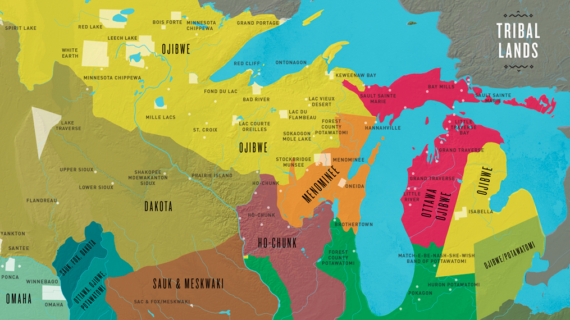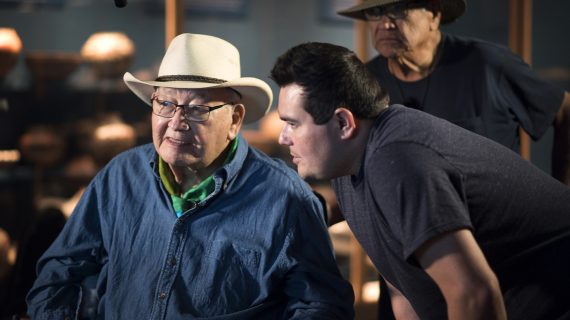– Welcome everyone to Wednesday Nite at the Lab, I’m Tom Zinnen, I work here at the UW-Madison Biotechnology Center. I also work for UW-Extension and Cooperative Extension, and on behalf of those folks and our other co-organizers, Wisconsin Public Television, the Wisconsin Alumni Association, and the UW-Madison Science Alliance, thanks again for coming to Wednesday Nite at the Lab. We do this every Wednesday night, 50 times a year. Tonight, it’s my pleasure to introduce to you John Brugge. He’s the professor emeritus in the department of neuroscience. He was born in Brooklyn, New York, and went to Baldwin High School on Long Island. Then he came out here to the Midwest to Decorah, Iowa, to study at Luther College. Then he went to the University of Illinois at Urbana-Champaign to get his PhD in physiology. Came here to UW-Madison in 1963 as a postdoc and never left. He started as a faculty member in 1966, and then retired from that after rising to full professor in 2003, and he’s been the emeritus ever since. And I lied, because then he went, and was a visiting professor at the University of Iowa for ten years, so you did leave, but you came back.
– I was a post-doc.
– Okay, sounds good. Tonight, as part of our commemoration of the centennial of the end of World War One, he’s going to talk with us about Invisible Wounds of War: A Challenge for Neuroscience on the 100th Anniversary of the End of World War One. It’s been pretty interesting to see, over the course of my lifetime, how neuroscience and brain science have interplayed with this whole idea of responsibility, culpability, and in this case, courage or the lack of it. John’s got a very interesting story to share with us tonight, please join me in welcoming John Brugge to Wednesday Nite at the Lab.
(audience applauding)
– Thank you, Tom, and all of you for coming out tonight. So let me take you back a century or a little bit more, and sort of do a quick recap of what was going on in the world at that time, and we find that the First World War, also known as the Great War, by some, it was a global war, started in Europe, started in summer of 1914. And the US was late in coming in, about three years late, but it joined in April of 1917. And during that four-year period, there was an enormous loss, mainly in Europe. There, about 40 million people died, civilians and military, and about 15 to 19 million deaths, and something like 29 wounded, so it was about the most deadly conflict in human history.
The US lost about 116,000 men, mostly men, and there were about 320,000 more sick and wounded. And at the end of the war, there were probably a million or two men still left there, to come home, some stayed, some came home, most came home. There were 122,000 Wisconsinites and about 4,000 of them died, and 192 of those deaths were students, UW students or recent grads. And as Steve Oreck, if you heard his talk last week, very nice talk on the influenza epidemic of 1918, killed more people than actually died in the war. And I didn’t appreciate this until Steve gave his talk. And in my reading on the war, there’s very little reference to the influenza virus that broke out, and that should have been important, because the carrier of the virus was, according to Steve, the movement of troops. So the troops are moving back and forth across the Atlantic, and they were carrying the influenza virus. So when we look at those that died in the First World War, it’s more than those that were killed on the battlefield. There were enormous numbers that lost their lives because of the activity of our military during that period. Now, that panel in the middle is one that I came across, maybe you’ve seen it. It was published this year. And it’s a photo of a film strip which was discovered in the Imperial War Museum Archives.
During the war, the French and the English had set up, I guess, they would be microphones, around the battlefield, recording the blasts that were coming from the artillery, the German artillery, and by looking at the signatures that they recorded, and they recorded them on film, they could determine which of the guns that were going off, and by the geometric triangulation, they could get a pretty good estimate of where the gun was. So they found these, and what I found was chilling, almost, is on your left, you can, I think you can see a lot of wiggles on that film. And the marks at the bottom are minute marks leading up to the 11th hour. And then there’s a gap, and then to the right, is the minute after the 11th hour, and it’s silent, it’s a flat line. And the engineers had taken the optical image and recreated the sounds that they thought must have come from that, and I didn’t bring those sounds along, but you can go to the web and find those and listen to those sounds, and I tell you, it’s pretty chilling experience to do that.
So the war ends on November 11th, 100 years ago last Sunday. And the guns fell silent, but it didn’t end there for an enormous number of people, men, who had to get back to their lives. And they found early in the war, that men on the battlefield were exhibiting what appeared to be a mysterious ailment. They would just suddenly lose their sight. They would drop, they would become dizzy, they’d lose sleep, they were fearful, they were hysterical, and for reasons I’ve never understood, they didn’t seem to know what it was. Despite the fact that those symptoms had shown up in warfare for 5,000 years, almost all of human history is filled with stories like that, and that’s where the term shell shocked came into our vocabulary. And it was first published in the British journal, The Lancet, by a man named Charles Samuel Myers. It was just a very brief, very brief entry into The Lancet, and he has three cases, and they were both very similar, of the men who lost their memory, vision, smell, taste, and then were admitted to the hospital.
And he says a couple things that I think are worth pondering. “Comment on these cases seems superfluous.” It appears to constitute a definite class “among others arising from the effects of shell shock.” This is the first time that the term shell shock shows up in the published literature. And secondly, “The close relation of these cases to those of hysteria,” which was a psychiatric term at the time, “appears fairly certain.” All right, so now, we’ve gotten shell shock, as we’ll see, it is no longer a term that is used, I mean, it’s used, but it has no particular meaning today. And even at the time, there was ambiguity to it.
But about a year later, a physician by the name of Frederick Mott was able to obtain the brains of two men who died of shell shock, which was called commotio cerebri, the commotion of the brain, without any visible, external injury, so it was a hidden injury of war. And he was also the first one to publish images of brain tissue, shown on the left. Cells which are undergoing changes that are related to neural damage, the top two panels, and the lower ones showing the distension of capillaries, which is also a hallmark of a traumatic event taking place in the brain. But here’s one of the interesting things which he wrote. He says, “Undoubtedly, the vast majority “of non-fatal cases of shell shock “are more emotional than commotional, and occur especially in subjects of inborn neurotic or neuropathic temperament, but the two conditions may be associated.”
And he says he emphasizes that, “The commotional symptoms are not influenced by psychotherapy.” So here he, actually, in the title of the paper, he equates commotio cerebri with shell shock, and down below, in the text of the paper, he enters into this ambiguity of, now, we’ve got an emotional component, and we have a commotional component, and the emotional component has to do with who knows what? The commotional component has to do with something like, some kind of brain damage, even though there are no external signs. So if we follow this a little bit, he came up with two hypotheses. This was in 1917, where the “Compression of gases “in the atmosphere– We’ll see what that means in just a minute– “that the cranium and spine is struck, as it were by a solid body, and the vibration is transmitted through bony structures to the cerebrospinal fluid, and thence to the brain and spinal cord, causing a molecular disturbance of the delicate colloidal structures of the neurons.”
That’s remarkably modern in its description. And the second was, “Compression is followed “by a corresponding decompression, causing liberation of bubbles of gas in blood and tissue leading to embolism.” And it turns out that we know that some of that is, by and large, correct. He had no way of knowing that, but he was wise enough to have figured it out from what he knew about the conditions on the battlefield and the structure of the brain.
Now, after the war, the initial investigate– So after the war, and this is a British report, in 1922, “the initial investigators in the field suspected an organic etiology of this condition, that is, physical brain damage. A commission convened by the British government after the war concluded that shell shock was a convenient evasion of duty, if not disguised malingering, and that no case of psychoneurosis or mental breakdown, even when attributed to a shell explosion or the effect thereof, should be classified as a battle casualty.”
And it’s known that in the field, there were some 3,000 soldiers, mainly British, that were brought up for treason and dereliction of duty. 300 of those, probably among those who were suffering from this mysterious malady, were shot, executed. And as the report shows, they were taken out and shot that dawn, that was the way it was, that’s just the way it was. And I find this interesting in another respect, that Steve Oreck last week was talking about the individuals who were caught up in the influenza, influenza epidemic, and they came down sick, and they couldn’t participate in the training exercises for the war. That was here in Madison, by the way. And they were called malingerers. They were called shirkers.
So this notion that these unknown, these were unknown factors at the time, but that the individuals who were suffering from them were somehow not, ’cause they were all men, they weren’t manly and therefore must be shirking their duties. Well, we want to look at what was introduced in the First World War, that was never seen before on the battlefield. The war was fought on a massive industrial scale. It’s the first time that an army was mechanized, airplanes were introduced, and so were bombs, really explosives, of the kind that were never seen before.
And we have to thank for that, two individuals. One you’ll recognize as Alfred Nobel, and he was the inventor of dynamite. And then there was Julius Wilbrand, he was a German, and he invented TNT. So the Germans had TNT, the Americans had dynamite. These were explosives that had never been seen before and they had properties that contributed to our somewhat confused understanding of what these head injuries were that showed no outward physical signs of damage. So these are the explosives that showed up on the battlefield, and we still see them today. For the first time, they’re called– The first is called a high-order, and this is a supersonic. Supersonic means that it travels at an enormous rate. It’s about five or six times the velocity of sound. And it’s over pressurized, called over pressurized, so you have a spike in the atmospheric pressure, about 1,000 times, and that’s called a blast shock wave. And these are the explosives: TNT, nitroglycerine, dynamite, and more modern ones, C-4, Semtex, and then ammonium nitrate fuel oil. So the trick with dynamite, which is nitroglycerine, nitroglycerine is very unstable, and so it wasn’t very useful as an explosive. But what Nobel did, he messed around with it and messed around with it and tried to figure out how can we used this, mix it with something, and make it stable enough so it could be used. And he figured that out, and was able to mix it with an inert substance or substances.
And how they show up as dynamite sticks, but that’s really what it is is nitroglycerine. And it’s stable enough so you can carry it around and easily use it. Then there are low-order explosives, these are sub-sonic. They do not have the blast wave, and this is gunpowder, so gunpowder came to us via the Chinese in about the ninth century, and it’s been used in warfare for all those years. And gunpowder doesn’t have the explosive capacity of the high-order ones, it really burns very quickly, and when it’s in a confined space, it develops a pressure that makes it a propellant, so it can heave a cannonball, for example, and a bullet.
And as a kid, I can, maybe you remember this too. You know, you got your first Gilbert, I think it was a Gilbert chemistry set for Christmas, and what are the first thing you do, right? You look for the sulfur, you look for the charcoal, and you look for the potassium nitrate or sodium nitrate, and you went up to your room and mixed it up, right, went out in the garage and hit it with a hammer or something, but that was gunpowder. And now there are what are known as manufactured. You can buy these things, or improvised explosive devices, IEDs, like we’ve come to hear so much about in the most recent Iraq and Afghan War.
So let’s look at what this blast is. This is the only graph I’m going to show you, but I think it makes the point, we’re plotting pressure on the Y-axis, against time on the X-axis, and time zero is when the explosion goes off. And you can see the very rapid rise in pressure. It’s almost instantaneous. And then it falls back, and it goes negative. So you get a very positive pressure…and then a reversal and a negative. This is over with, from the dotted line at T-zero, to the beginning of that negative wave, in milliseconds, thousandths of a second, very fast. Well, that depends on what the explosive is, and the environment and so forth, and this is an idealized pressure wave.
So that’s what we’re dealing with that wasn’t dealt with before, and so one question is going to be, well, how does the pressure wave interact with biological tissue, brain tissue in particular? Is it part of the damage that’s created with a traumatic head wound, and to what extent, and how is that damage created? So there are different types of injuries by these explosives, so the first one is often called an overpressure of the blast wave. This was the one that I just showed you. The second, which follows the blast wave, comes a wind, it’s called the blast wind. It’s a pressure wave that picks things up. So things get flown around, debris, bomb fragments, rocks, bricks, any number of things. And so these things, for any individual that’s in the vicinity, can be struck, can be struck in the head, and even though they’re wearing a helmet, say, may or may not be protective enough. The individual can be thrown, picked up, and tossed, and they would hit the ground, they may hit a building, who knows. But it’s another potential for a traumatic head injury, and then there’s sort of all the other stuff that goes along with it, the gases and heat and so forth. But the ones that we want to concentrate on are the primary and the secondary and tertiary ones, and see how they contribute to a traumatic brain injury.
A little bit about the brain. So this shows an exposed diagram of an exposed brain on the left. It’s covered by a very heavy membrane called the dura mater. It’s now shown here cut and pulled back, and you can see on the surface, the veins and arteries which are embedded in two other membranes, very thin membranes that lie on the surface of the brain. To the right is a photograph of an exposed human brain, something you might see looking over the shoulder of a neurosurgeon once he takes the cap of bone off and opens the dura, and I put it there as kind of so we appreciate what might happen. You can almost imagine what might happen if the head is struck in such a way that forces are applied to that brain tissue. We’ll take a closer look at that.
Now, if we look at the brain in cross section, it gives some clues as to what might be happening. On the top is a cross section, just cut like that, a slab, actually, from autopsy material, unstained, and you can see on the edges, the dark surround, known as the gray matter, and that’s where the nerve cell bodies lie. They’re packed in there by the millions, and the white area is called white matter, and those are the axons of those neurons, covered by myelin, so they’re myelinated axons. These are the large axons, and they are connecting distant areas within the brain and between the brain and spinal cord. And below, you can see stained on the left, the cell bodies stained for microscopic study, and those are shown in blue. And on the right is a section pretty close to this one, and which is stained for myelinated axons, and those are in the black. So we get a sense, you start thinking about what happens if the brain gets distorted by a blow to the head, either a blast or if something strikes it or if the head strikes something, what might be going on here.
Let’s look at the blast wave first. So this is a model, we really don’t know what a blast wave does in a complex tissue like the brain. But the time, so these are four instances in time, of a blast wave moving from your left to right. And this is time in milliseconds. So this is a blast wave that enters the brain, and within a fraction of a millisecond can actually pass right through the brain. Now, the blast wave is, from a physics standpoint, and the physics of blast waves are pretty well known, behave like most other waves, like sound waves, for example. So they can meet and interface, and when they meet at interface, they interact with that interface, can be reflected back. Some of it passes through, can be refracted, bent. So we don’t really know what the biomechanics of a blast wave is, and this is one of the crucial things to come to understand if we’re to ever understand what the mechanism is of blast wave injuries.
So for secondary and tertiary injuries, this is where either something strikes the head or the head strikes something. This is an acceleration-deceleration injury. So the brain, as we saw, is sitting in a hard skull, surrounded by a thin layer of fluid, cerebrospinal fluid, so in a way, it kind of sloshes around. Now, under normal circumstances, like we shake our head and stuff like that, the brain can take that, no problem. But there’s a point, there’s a threshold, where too much of that, too much of that acceleration or deceleration, is going to create an injury, and this is what that looks like, diagrammatically. So, sitting there, on the upper left, is the head in place, and let’s say something comes and whacks the front of the head, like that, throws it back violently.
Because of the inertia of the brain, it moves differently than the skull, and what happens is that the frontal lobe actually crashes into the front of the skull. The secondary to that is the head, now, is thrown forward, so you now get a contra injury, it’s called a contrecoup. And then, in a post-injury, you’ve now got, what that little cartoon is up there, is meant to show a neuron, meant to show a neuron which is damaged, as a result of that. So these are two things that are affecting the brain. The blast injury, and an impact injury that results in head acceleration and deceleration. Now, this is shown with a head thrown front to back. Now, of course, in a situation, say, on the battlefield, where an individual soldier is thrown, his head can be hit from any direction, or it can hit anything, and it’s, one of the things which is most damaging is an angular acceleration, something which is a twisting motion like that. And it might look something like this.
So now, heres a head that’s flipping like this. And if you remember the picture of the brain, the brain sits in the skull. There are two hemispheres to it, one here, one here, divided down the middle, separated, they’re separated for a long distance, but that space is occupied, and it’s occupied by a septum. It’s a membrane, it’s a thick membrane of dura and a vein, sitting right there. So now, let’s think if the head is thrown to one side, you can see what could happen. One is on that mannequin, the right cerebral hemisphere, the one that’s upward, hits up against the dural membrane at the midline, and the one on the right, the left hemisphere, continues moving, and what happens is, you get a spreading of the hemispheres.
Now, if you remember, what’s connecting those in the lower right, you see the white matter connection between the left and the right is a very large, very large bundle of axons, myelinated axons called the corpus callosum. This is what allows the two hemispheres to talk to each other. One of the most damaging effects of having a traumatic head injury like this is an axonal injury, so not only are the neurons themselves damaged, but more damaging, in fact, is the twisting and turning and stretching of axons. There’s a limit to how far they can go. And we’ll see some pictures of that at a microscopic level. Think about, it’s sort of been likened to having silly putty, so you get a silly putty and you pull it out and do it slowly, it stretches out, goes back. But if you give it a good snap, you break it. And that’s kind of what happens here.
So now we’re dealing with what, in 1914, was called shell shock, with its ambiguity between an emotional component and a commotional component. The commotional component, we can consider it now being what we call a traumatic brain injury, TBI. The emotional component, which comes down to us as post traumatic stress disorder. Now, how they got these names isn’t really important, but those are kind of, sort of semi-interesting stories. At any event, we now see continuing forward 100 years, we still have now two conditions to deal with. One is the result of a physical trauma to the head that doesn’t leave a scar, that is, an external scar, and then we have an emotional component over here. And to what extent do they relate to one another, or do they? Now, that’s a complex story, and so, I’m not going to go there.
(audience laughing)
But, so what I’m going to do is I’m going to take off PTSD. The circuitry involved, the neurocircuitry in the brain involved with PTSD is becoming understood. And it’s different than the injury of a TBI, although a TBI may also involve a circuit involved with PTSD, if that makes any sense. So let’s now focus on a traumatic brain injury. So, like I said, traumatic brain injury comes about through the result of an acceleration or deceleration of the head in a violent way. What the threshold is, we don’t know, and that can be mild. We see it all the time, somebody gets a concussion. They may not be unconscious, they’re kind of woozy. Used to, in the old football days, call it having your bell rung. And people usually recover from it, might take a little while, but then they’re back on their feet, and for all intents and purposes, considered to be recovered. All right.
In the returning vets, we’ll see there was about 80% of returning vets with head injuries that were of the mild type. It’s an injury, it’s hidden, and they go their way. There are more traumatic ones, which we’re going to kind of put aside and look more at those for which, we don’t know what the long-term consequences might be. So let’s just look where research has taken us over the last 100 years on these two injuries. So this is not a super scientific study, and it wasn’t, it’s not mine, but somebody went to the trouble to search the literature over the last 30 years, from 1990, so it’s years on the X-axis, each bar is a year, out to 2016. And on the Y-axis are the number of articles, published articles in peer-reviewed journals, that relate to traumatic brain injury of the mild type in the military.
And for about the first, from about 1990 up to 2010, right, 20 years, and then backward to the 20s, there’s almost nothing published on it. Now, why would that be? Well, it isn’t though it wasn’t known. It really comes out of the history of boxing. So in the 20s, it became recognized, and there was a paper published on boxers who were exhibiting the same kinds of behaviors as soldiers that came off the battlefield in shell shock. So the natural thing was, well, these boxers are like that because they’re getting beat up, they’re heads are getting– So this must be the result of repeated blows to the head. And it was called the punch-drunk syndrome. And they discovered that yes, there is, even though you can’t see this damage, these are damaged brains, that was 1928.
From ’28 onward, as far as we know, even in sports, there was very little, very little that was published on it. Of course, the other thing is that, after the war, we kind of drop our guard. People, soldiers go home, life goes on. People forget about it, except the people who have to live with it, but there’s really not much of a recourse. And, there’s no public policy developed to fund research of the kind necessary to really understand what’s going on. So if you don’t have funded research, you don’t have researchers, and you don’t have papers published, so it’s simple as that. So what happens, the gray bar there is 9/11/2001. And now, we enter into Iraq, Afghanistan conflicts, and for, oh, I don’t know, eight or nine years, there’s still nothing going on. Still nothing going on, and why is that? Well, after 2001, there were two million or so service members deployed in Afghanistan and Iraq. And about 350,000 of those sustained a TBI. And about 82% of those were considered mild concussions, right, but head injuries. Oddly enough, the Department of Defense, prior to 2010, had never required a medical examination of soldiers on the battlefield that had head injuries, except to have them self-report. Now, if you think about this, you’re on a battlefield. You’re blown away, and not silly, and they hand you a piece of paper and say, “Well, tell us what happened.” Well, I don’t know what happened, I can’t remember this, and so on.
So in 2010, they changed from self-reporting to a medically diagnosed, clinically documented and mandatory screening for specific events. And it’s where that arrow is right there. So, things start to pick up about then. Now, there are a couple of other things that were going on, unrelated to the military, which I think sort of will tie some things together here. And to introduce you to two people, three, one you don’t probably have to be introduced to. So one is a fellow by the name of Bennet Omalu. You may remember him. Bennet Omalu was a forensic pathologist, neuropathologist in the Pittsburgh area. Nice guy, doing his job.
Below is Mike Webster, Mike Webster, you no doubt have heard, Mike Webster was a football star here at UW. 1974, he was All Big 10, drafted in the fifth round by the Pittsburgh Steelers, and played with them up until 1990, then he went to the Chiefs. But he was All-Pro about seven or eight times. And he was a center, and an aggressive one, probably considered one of the best of the interior linemen in the NFL. Mike Webster fell on bad times. And he had serious mental issues. Physically he became a wreck. And he died at the age of 50. And quite coincidentally, Mike Webster now meets Bennet Omalu on the autopsy table. You remember this story, perhaps, from the movie made, which was called Concussion. Will Smith plays Omalu, so a wonderful picture, movie.
So Omalu, as the story goes, does the autopsy. He looks at Mike Webster, never heard of Mike Webster. He doesn’t know anything about football. He’s a Nigerian doctor, hasn’t got a clue about American football, but he looks at this wrecked body and then takes the brain, and the brain doesn’t match what the body tells him. He was totally surprised. And he said, “Well, what’s going on? “What went on with this man?” And so he carried that through and he sectioned that brain and stained it and began to follow a lead here, as a good neuropathologist would do, and made an important discovery. And I’ll get to that in a second, before we see Ann McKee. Now, Ann McKee is a neuropathologist, her specialty is in neurodegenerative disease. She’s at the VA hospital in New England, she’s a UW grad. She graduated the same year Mike Webster did, in 1974. So she went her way and Mike went his. She’s from Appleton, Mike’s from Tomahawk, went to Rhinelander High School. And Ann McKee became interested in Omalu’s work when he described Mike Webster’s brain. And then, that eventually led to looking at the brains of individuals who fought in Iraq and Afghanistan.
So now things shift, but it was the discovery that Omalu made in the brain of Mike Webster as a sports injury, which now carries over into looking at traumatic brain injuries in the military. So I’m going to show you some of the images. So these are two images published by Omalu. On the left was published in 2005. And the right was published in 2009. So on the left, you see that dark staining in the cell. That’s an abnormality, and the abnormality is in a protein within the cell. It’s called the tau protein, and the tau protein is a protein which does a number of things, but one of the important things it does is it stabilizes the neurotubules in the cell, and particularly the axon. So these are like long hollow noodles that run down the length of the nerve cell, and they have to be held in a certain configuration, and this is what the tau proteins do, but for some reason they can become distorted. And so they take on weird shapes and they become tangled and these tangles now result– And they can be stained for selectively, so this is a selective stain for an abnormal tau protein on the left.
On the right is an Iraqi war veteran in a paper published also by Omalu just four years later, in 2009. Very similar, very similar. So now we have a connection between an injury took place in sports, head injury, and one which has now taken place on the battlefield. And he called this, he named it, chronic traumatic encephalopathy, CTE, and that’s come down to, now that’s been used, and is being used, it kind of fits in to the categories of brain injury, and the size of brain injury, but it has its own pathology. So it’s characterized anatomically by these protein tangles that can be selectively stained for.
And believed to be, believed to be, and this is really important, believed to be a result from repeated blows to the head, resulting in multiple concussions, and is characterized behaviorally by memory loss, problem solving ability, depression, anxiety, aggression and so forth. Very similar to some of the symptoms observed in patients with neurodegenerative diseases like Alzheimer’s and Parkinson’s disease. So we have now a situation where we have sports injuries which are making headlines. If you read the papers about the traumatic injuries to football players, but it’s not just football players, it’s amongst all of the sports that have physical contact, you would think that boy, every football player out there is going to end up with a chronic traumatic encephalopathy. Well, Ann McKee, who has studied now 120 of these, maybe, published them, all but one she says, she’s found these tau particles, abnormalities, even in very young players. Ergo, this is a very dangerous sport, which it could very well be.
But then, you start thinking, well, how many individuals have played football at a pretty high level? Thousands, thousands and thousands. So we have a case here where, from a scientific, and experimental design point of view, there are some weaknesses. It’s a sampling problem, because all of the brains that have come to these labs have been volunteers, self-selected, and people who have donated their brains because they had the symptoms that lead them to believe that they’ve got some sort of traumatic brain injury. So it’s sort of a circular kind of situation. Well, you say, what do you believe? How do you believe it, what kind of weight do you place upon something like that? Well, the weight, as I see it, that you place, is you say, well, and there are several labs that are doing this now, coming up with the same observations.
Ann McKee has looked at thousands of brains. She knows what this stuff is, she’s studied this stuff. And when she says, I’ve never seen anything like this before and it’s highly unusual that a 24-year-old, 19-year-old brain would have this stuff in it, say well, we have to assign some weight to that. On the other hand, is there any way that we could actually design a scientific experiment to test that? And we’ll see how we might do that in a minute. Okay, I’m going to show you some more pictures of this. This is another from McKee, a healthy brain shown on the left, stained up on the right, the aggregated tau proteins from a 45-year-old retired football player. So these are sort of standard, now seen quite frequently.
Here’s again, comparing on the left, a normal healthy brain, a low power on the top and a high power on the bottom. In the middle is a retired NFL linebacker. And you can see the dark staining on the top, and higher power at the bottom, and on the right is an old boxer who lived to be 73. And his brain is pretty well messed up. But again, there are a lot of boxers who are walking around having been pretty well beaten up but they seem to be in otherwise pretty good shape. All right, so now McKee has, and her colleagues– this is from McKee’s lab– have collected a fair number of these from individuals in the Iraq-Afghan Wars. And so she has maybe 100 that she’s reported on. Something like 60% of them show this tau protein abnormality. Well, and the headlines on this would be: 27-year-old military veteran of Iraq-Afghanistan showing signs of CTE. The other is, she would say, they would say, this was done because of a military blast exposure. So here we come back to– Well, okay, we see that these individuals have abnormal proteins, so they have an abnormal brain, and we know that a traumatic blow to the head could be associated with that, but how about a blast? How do you separate a blast from the, from a traumatic head injury, or is the blast a traumatic head injury?
We don’t know, because in the heat– I’ve never been in the heat of battle, but I can picture it. How could you separate one from the other so that you had a pure blast injury or a pure traumatic head blow? So that’s another one of the things to keep in mind as we try to interpret this. There are other proteins which are abnormal. These are glial cells. Glial cells are the non-neuronal cells in the brain, have a lot of functions, involved and show up in cases of inflammation and of injury. On the left is a healthy brain, on the right is a military, again, blast exposure. You see the brown showing abnormal protein this time. It’s a different protein when associated with a glial cell called an astroglial.
And as I mentioned, the axonal pathways are particularly susceptible to stretch. And this is an MRI, a special kind of an MRI, which allows one to track long myelinated axons. And it’s color coded, so each of those colors represents a neural pathway connecting one part of the brain to another. Just to emphasize that you can, by distorting the brain you can easily stretch those. And the report on that– This is one of the earliest reports on brain damage to axonal injury, back in 2000. On the left you see these black images. They’re swellings, those are axons which are swollen. This is now a staining for a neurofilament protein. Or, there are bulbs on the right, see these kind of expansions. In any case, these are abnormal, and so one would expect that whatever these axons were connecting or are connecting, it’s going to be an abnormal connection. The information flowing from point A to point B in the brain is going to be affected.
How else could we study that? Well, the big hope is that we would use some non-invasive imaging technique. One of the problems here is that the traumatic brain injuries are discovered only postmortem. So we really want to find something to be done in a living human being. And these images, imaging techniques, show some hope, but they’re not selective enough, they’re not sensitive enough, and they’re not cheap enough. You could never do this on a large scale with the current imaging techniques. So in special cases they can be done.
Okay, let me just take you to one example of how we can now begin to track the mechanism of blast trauma against a blunt head injury. So this is being done out at the VA hospital there, with a mouse, with mice. On the lower right, it’s called, what’s a blast tube, it’s a long long tube, divided down the, divided by a membrane, and behind that membrane is built up a high pressure. At the other end, at the end of the blast tube here, is a little mouse under anesthesia, strapped down to a board, sideways to the blast tube. They fill that chamber with gas until the membrane ruptures, it shoots a blast with a profile similar to the blast profile I showed you earlier, and it hits the mouse. Now, you can calibrate that in such a way that the mouse gets up, shakes himself off, recovers, does okay.
One of the interesting things that they did with this is they set up a camera above the mouse’s head, a very high-speed camera to capture the movement of the head when the blast hit. So, there’s, on the X-axis, is movement in one direction, Y-axis is movement, distance, in the other, and if you track the arrows, you see that when the blast goes off, which is over there on the right, by that red bull’s-eye, the head, it shoots up to the left in 15 milliseconds. It’s there, it then makes a left-hand turn, does a circle, 20 milliseconds, is up in the corner, 30 milliseconds is over here, and then it’s back to rest. So this whole event is over in about 30 milliseconds. And what is it, it’s a bottle head. That little mouse is just there, and it just goes, boop, like that. Just jolts him. So the mouse gets up, shakes it off. Well, what the mouse didn’t know is that something happened. So on the left is a healthy mouse, the right is a blasted mouse. The external features of the mouse look the same. You don’t see a lot of trauma, you don’t see broken blood vessels and so forth. But below, you see on the left, the tau protein for a healthy mouse. And on the right, of the blasted mouse. So even though there’s no outward sign, and the mouse is up walking around, it’s got the same kind of, same kind of injury that we saw with a blunt instrument.
– [Audience Member] How many blasts?
– One, it just takes one, but they did a whole bunch of experiments yet. It’ll happen with one, and down below shows another molecule that also shows up, which is a molecule that shows up in brains where there’s an injury. So the idea here is now that what the blast does, one thing the blast does, is while it may, itself, interact with brain tissue, it actually just shakes the head. So, an individual who’s out in a field and now is next to an IED, gets a blast, that blast reaches him or her in milliseconds, passes through that brain in milliseconds, and gives a jolt. Just a jolt, now, we have to scale that, of course, from a mouse to a human, but that’s the kind of experiments now that have to be done in order to be able to sort out what the different mechanisms are for these two kinds of injuries.
All right, so this is the cascade, and we’ll just kind of review here. So the physical forces act on the brain tissue. Brain tissue, blood vessels are distorted and torn. Inflammation can take place, the blood brain barrier, which I haven’t talked about, could break down. Axonal injury, astrocytes develop. And from there, things get a little bit dicier. So you get tau protein tangles, amyloid plaques, we haven’t talked about amyloid, which also shows up sometimes in these damaged brains, and neuronal death and neurodegenerative disease. So this is all very iffy, because one of the fears is that, and one of the thoughts is that damage, even though it isn’t a major traumatic event may eventually, through a cascade like this, or with other intermediaries, lead to a degenerative brain, an Alzheimer’s brain, a Parkinson’s brain, ALS brain, we don’t know.
So here are the challenges, and there are many others. What are the biomechanics that trigger traumatic brain injury? What are the cellular and molecular events? Can these be arrested or reversed? What are the other factors, age, genetics, contribute to traumatic effects of brain injury? Is there a risk factor for neurodegenerative disease? What needs to be done to develop biomarkers? This is really critical, because as I said, we’re now diagnosing this in postmortem tissue.
What we really need to do is know what’s happening in the living human, and we have to know it right away, and we have to know it in a large scale, and that means cost, one of the really critical things. So biomarkers, those molecules that show up in the blood or in the cerebrospinal fluid, urine, for example, that correlate with brain damage, or more sensitive brain imaging. We don’t have that yet. What do we have? Well, in 2013, Obama announced what was called the Brain Research through Advancing Innovative Technologies, acronym BRAIN, pumping billions of dollars into brain research over the next 10 years.
This is just a– What this really means, and this is not just the US, but this is taking place also in the UK, and many countries, in sharing data and trying to get at some of these really knotty problems. And you can see all the contributors to that. Here, in traumatic brain research, the major player is at the bottom. It’s the Alzheimer’s Disease Neuroimaging Initiative. This is a 10 year– Well, it’s more than that– Started in ’04, and goes all the way up until ’21, trying to understand the mechanisms underlying the development of Alzheimer’s disease. And here, they’re doing it in a very careful, controlled way. And preliminary results are just starting to come out, so it’ll be in the next five to 10 years, we’ll see some advances here. So this is where we come in 100 years, H.G. Wells in a book, War to End Wars. Woodrow Wilson picked that up, it became the slogan of the First World War. And Alfred Nobel, the man who contributed so much to what’s happened on the battlefield then and now, he says, “My dynamite will sooner lead to peace than a thousand world conventions. As soon as men will find that in one instant, whole armies can be utterly destroyed, they will surely abide by golden peace.”
But Lloyd George probably had it right when he said, “This war, like the next, is a war to end war.”
Well, thank you so much for coming.
(audience applauding)
Search University Place Episodes
Related Stories from PBS Wisconsin's Blog

Donate to sign up. Activate and sign in to Passport. It's that easy to help PBS Wisconsin serve your community through media that educates, inspires, and entertains.
Make your membership gift today
Only for new users: Activate Passport using your code or email address
Already a member?
Look up my account
Need some help? Go to FAQ or visit PBS Passport Help
Need help accessing PBS Wisconsin anywhere?

Online Access | Platform & Device Access | Cable or Satellite Access | Over-The-Air Access
Visit Access Guide
Need help accessing PBS Wisconsin anywhere?

Visit Our
Live TV Access Guide
Online AccessPlatform & Device Access
Cable or Satellite Access
Over-The-Air Access
Visit Access Guide
 Passport
Passport


















Follow Us